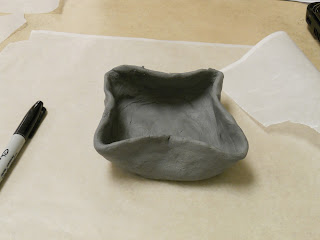 |
| Stratified rock formations at top of Calcite Mine |
It was a 4 mile roundtrip hike, and we're not sure the altitude past 1,000 feet, but there were places where it was much higher. I only had trouble with the altitude when we got to the Calcite Mine itself, which I'm guessing was over 1,500 and maybe closer to 2,000 feet above sea level. There were some really amazing formations, like Slot Canyon, which is a small canyon of smooth rocks barely big enough in some places for a person to fit through, and smooth enough in places that it is almost impossible to climb up. I was proud of myself for only needing help climbing up in one spot.
 |
| Slot Canyon |
There were some great places where you could see the stratification of the rocks, and you could see veins of quartz and calcite. None photographed well, so you'll have to take my word on that. We stopped for lunch at the highest part of the Calcite Mine, which is the only spot I had real trouble. Very little wildlife showed itself, although I have no doubt coyotes, bobcats, ring-tailed cats, jackrabbits, and others are around when people are gone. We saw evidence of rabbits and deer hoof prints. Which was exciting because that morning Jessica and I were up at the museum looking at where our cacti were being eaten and found prints that were bigger than deer. So we maintain we have big horned sheep eating the cacti. Which would be cool if we could ever see them in person. On the hike up we saw a baby horned lizard, which is apparently becoming a rare siting.
 |
| Baby horned lizard, trying to blend in, with a comparison penny |
And I figured out how to use my camera for movie images. Which could be cool in the future as I figure our what I'm doing.







